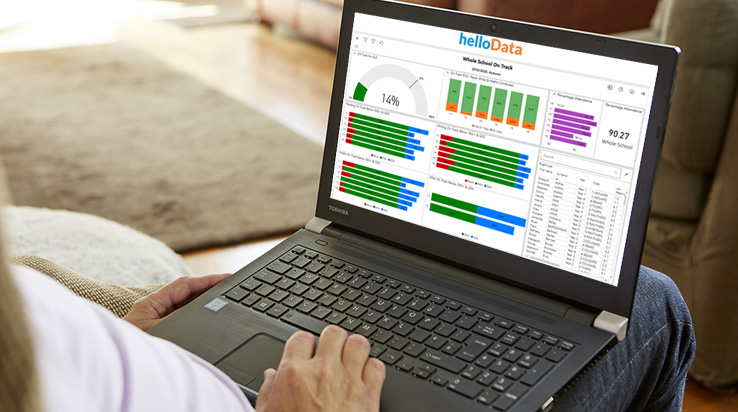
With the 2014 national curriculum for England fully bedded in, and the new Ofsted Education Inspection Framework off the blocks, many schools are now immersed in a new phase in their planning for curriculum and assessment. Building on their initial approaches to assessment in a world beyond ‘levels’ and feeling more confident and empowered to look afresh at assessment in a way that suits their curriculum and school context.
The recommendations of the ‘Making Data Work’ report by the Teacher Workload Advisory Group and Ofsted’s more holistic, curriculum-focused approach to evaluating standards, mean that leaders need to look at how in-school assessment is carried out and the level of recorded data required.
In one of our most recent webinars for school leaders, Kim Marczak from helloData talked us through Streamlining assessment tracking and reporting to drive school improvement.
A changing assessment landscape
It wasn’t all that long ago that in-school data tables were considered one of the most important parts of an Ofsted Inspection. Meticulous tracking of pupil achievement against the national curriculum levels was de rigueur, with assessment points six times a year, a mammoth amount of box ticking, and a ton of laborious, time-consuming data collation. The Commission on Assessment Without Levels, instituted as part of the new curriculum development process, recognised that NC levels had taken on a life of their own, outstripping their original purpose, and often doing more harm than good to school improvement. They argued that the removal of levels would provide an impetus for pedagogical change, increasing pupil motivation and engagement and making better use of formative assessment in the classroom. By removing levels, the intention was to reduce the time spent by teachers in recording and tracking progress towards numerical targets and release time for more in-depth teaching and formative assessment approaches that would support progress across the attainment spectrum.
But how successful was the removal of Levels in achieving this aim? The 2018 NFER Assessment without Levels qualitative research report, funded by the DfE,1 showed that three years past the abolition of levels, the impact on teachers and pupils was still a little mixed. Most teachers and senior leaders reported that they were now focusing more on formative assessment and that their non-statutory assessment approaches were more curriculum-led and effective than before AWL; they felt that the quality of feedback and communication had improved. However, many teachers also felt that the lack of national standards for non-statutory assessment had undermined their confidence in making summary judgements of pupils' attainment, while a few also reported an increase in workload directly related to their school's new assessment approach. The report concluded that: "the influence of statutory national assessment is still clearly apparent in schools' non-statutory assessment and continues to be the main driver for formative and summative assessment."
Part of the problem perhaps, is that while the removal of national curriculum levels gave schools immense freedom to choose their own approaches to formative and summative assessment, it represented such a departure from what had come before that it left some leaders feeling uncertain and insecure as to how to fill the void. Data felt like something of a safety net, prompting many schools to buy into third-party assessment systems that promised accurate benchmarking and micro-level reporting against the new descriptors of ‘working towards’, ‘‘expected’ and ‘‘greater depth” expectations, which schools were now needing to understand. However, despite these assessment systems being well constructed, they were often generic, offering assessments and tests that did not necessarily fit with individual schools’ curricula for the core subjects. Many schools found them to be unreliable in helping teachers to see whether pupils were on track and, ultimately, unless the tests were a perfect match for their curriculum, they were also of only limited use in generating specific, actionable insights to feed back into their teaching and improve pupil outcomes. Third-party systems provided lots of data and interactive reporting all at the click of a button – but to what end?
Moving from data to day-to-day
Ultimately, non-statutory assessment needs to be a core part of each school’s curriculum design. "The curriculum choices you make will determine the key milestones on which your summative assessment should focus. They will probably also determine the choices you make about what data to collect," says Ben Fuller of Herts for Learning.2
With Ofsted no longer requiring in-school data it is possible to make some brave decisions about what stakeholders really need to know: what the purpose of the data is and how it improves outcomes. While it remains important for subject leaders, senior leaders, governors and trustees to have oversight of key trends across the school in order to have a good understanding of strengths and weaknesses, there is real clarity in the Ofsted EIF that the purpose of assessment is to check pupils’ understanding effectively, in order to inform teaching.3 If we accept that teachers are informally and formatively assessing their pupils all of the time, creating a broad and balanced picture of each child’s capabilities and progress against the school’s curriculum, then we should be asking what actual value time-consuming data collection adds. And as summative assessment results (particularly from best-fit third-party tests) can only be considered an indicator rather than a robust and accurate determiner of a child’s attainment and progress, nor should data be used as a tool for teacher performance monitoring. The conclusion is clear: minimise data recording and reporting and focus on day-to-day action in-the-moment feedback, more identifying and correction of misunderstandings.
Watch the recording of our webinar Streamlining assessment tracking and reporting to drive school improvement to hear more from Kim Marczak about how you can minimise the data you are collecting, and how a Management Information System such as RM Integris combined with helloData can help save you time and money while providing your stakeholders the key information they need in an easy to view, easy to use format.
